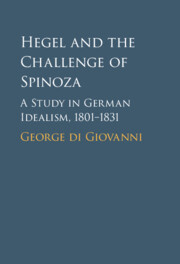Book contents
- Hegel and the Challenge of Spinoza
- Hegel and the Challenge of Spinoza
- Copyright page
- Dedication
- Contents
- Preface
- Abbreviations
- Chapter 1 Introduction: The Spinoza Connection, or the Discovery of “Feeling”
- Chapter 2 The Nature of “Nature” in Contention
- Chapter 3 The Transcendental Spinozism of the Wissenschaftslehre
- Chapter 4 Schelling’s Prophetic Spinozism
- Chapter 5 Schelling, Hegel, and Positivity
- Chapter 6 Of Things Divine and Logical
- Bibliography
- Index
Chapter 3 - The Transcendental Spinozism of the Wissenschaftslehre
Published online by Cambridge University Press: 17 September 2021
- Hegel and the Challenge of Spinoza
- Hegel and the Challenge of Spinoza
- Copyright page
- Dedication
- Contents
- Preface
- Abbreviations
- Chapter 1 Introduction: The Spinoza Connection, or the Discovery of “Feeling”
- Chapter 2 The Nature of “Nature” in Contention
- Chapter 3 The Transcendental Spinozism of the Wissenschaftslehre
- Chapter 4 Schelling’s Prophetic Spinozism
- Chapter 5 Schelling, Hegel, and Positivity
- Chapter 6 Of Things Divine and Logical
- Bibliography
- Index
Summary
After his controversy with Schelling, Fichte orally presented several new versions of his Science in which he adopted, if not a new standpoint, certainly a new methodology that had repercussions for the earlier standpoint. Where the “I is I” was the principle of the earlier Science, the trope of “light,” used alternatively with Evidenz and Reason, was the new principle. Where Fichte had earlier urged his auditors to engage in productive thinking, he now encouraged them to practice “attention,” an attitude of being actively engaged in the passive reception of the objects that presented themselves to their grasp. They had to detect in them, but only indirectly, the source of the intelligibility that made their presence compelling yet itself remained unseen. The aim was to let this source pervade one’s life. Fichte was adopting a new kind of realism which was in fact more consistent with the monism to which he had been committed from the beginning. Chapter 3 explores in detail a key text of 1804 in which these changes are introduced. The ontological quietism to which Fichte’s Science now led was one possible existential attitude that the assumed monism fostered.
Keywords
- Type
- Chapter
- Information
- Hegel and the Challenge of SpinozaA Study in German Idealism, 1801–1831, pp. 57 - 87Publisher: Cambridge University PressPrint publication year: 2021

